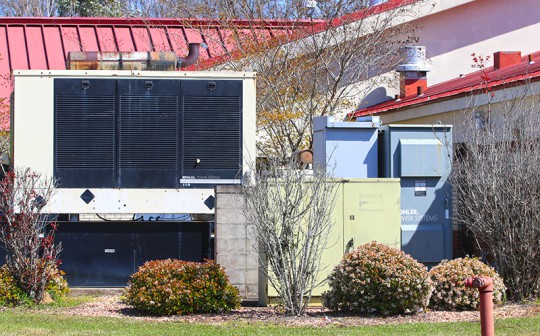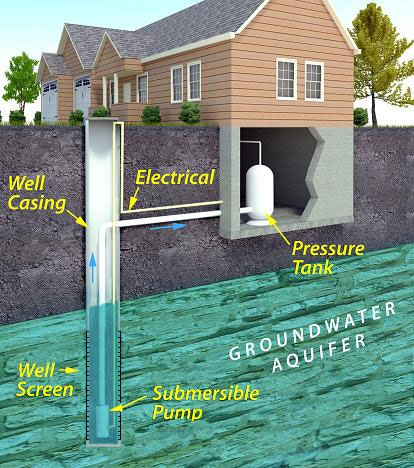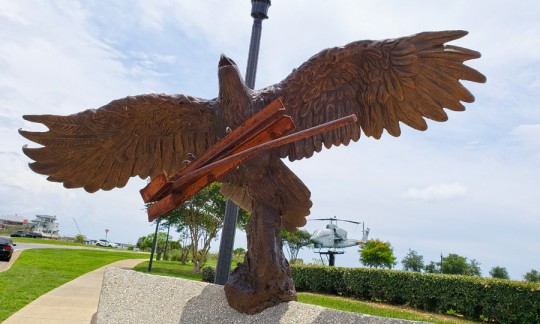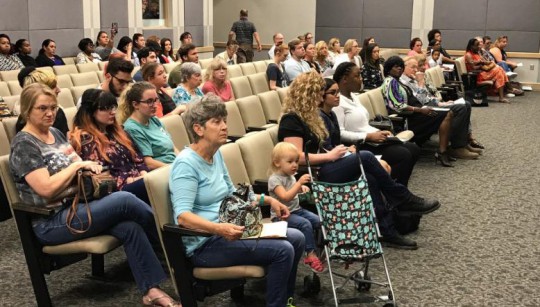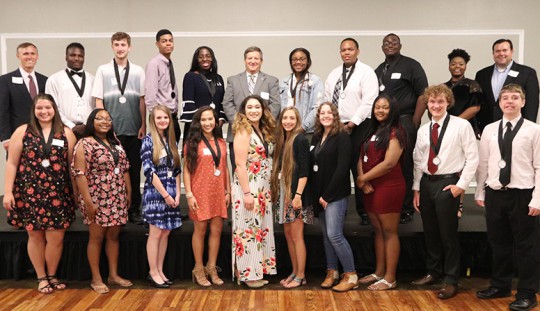Many Nursing Homes, ALFs Don’t Meet Generator Requirements
June 2, 2018
Months after Gov. Rick Scott promised a hard line against nursing homes and assisted living facilities in the aftermath of Hurricane Irma, much of the industry is not in compliance with new rules as the state heads into the 2018 hurricane season.
Scott pushed to require that nursing homes and assisted living facilities have backup power systems to make sure that residents can remain cool for 96 hours in case buildings lose electricity.
The Agency for Health Care Administration this week released data showing that nearly 66 percent of nursing homes in the state have complied with the new rules but that only 18 percent of assisted living facilities have done so.
Mallory McManus, a spokeswoman for AHCA, said the state expects full compliance with the rules, which required special approval from the Legislature because of the steep costs for businesses. The state will cite facilities that aren’t in compliance, which could lead to fines, she said.
“AHCA will stop at nothing to ensure assisted living facilities and nursing homes are following this important rule,” AHCA Secretary Justin Senior said in a statement. “We will hold all facilities accountable.”
But compliance doesn’t necessarily mean that facilities have equipment, such as generators, and fuel in place to meet the requirements, which call for being able to keep buildings at 81 degrees Fahrenheit for 96 hours. That’s because nursing homes and assisted living facilities that requested six-month extensions to meet the mandates also are considered compliant, McManus said.
A review of the data shows that 102 nursing homes can meet the requirements and that 348 facilities have asked the state for more time. There are 686 nursing homes in Florida.
The data is as of May 25, a week before the requirements took effect Friday with the start of hurricane season.
Florida Health Care Association spokeswoman Kristen Knapp said nursing homes that requested extensions could face challenges at the local level such as delays in zoning approvals.
“I don’t believe it’s fair to say that if a facility submitted a request for an extension it doesn’t mean they won’t be ready,” she said in an email.
Likewise, 205 assisted living facilities have proper equipment to meet the mandates. Another 344 are deemed in compliance because they have approved extensions or have submitted extensions. Six requests for extensions have been denied.
Unlike nursing homes that will be able to offset the costs of equipment with Medicaid funding, there is no assistance for the 3,102 assisted living facilities in the state.
Skip Gregory, who served as Florida’s chief of health care facility plans and construction for 17 years, said the industry is moving to comply with the new rules but that it takes time.
“It’s not as simple as snapping your fingers and saying. ‘Let there be air conditioning at all nursing home and ALFs,’ ” he said.
But Gregory said there still are “gray areas” regarding the rules and rattled off a number of issues such as long-term storage of diesel fuel and the use of natural gas for generators.
He also warned that allowing assisted living facilities to use gasoline generators to meet the requirements is a mistake.
He predicted that it would take 100 gallons of fuel to keep the generators powered for 96 hours and said owners of small ALFs would stockpile five-gallon gas tanks.
“I just don’t think that’s a good idea,” Gregory said. “That’s like a bomb waiting to go off.”
The rules are not what Scott initially sought in 2017 after the deaths of residents at The Rehabilitation Center at Hollywood Hills in Broward County following Hurricane Irma. The hurricane knocked out the nursing home’s air-conditioning system, leaving residents in sweltering conditions for three days. Authorities have attributed 12 deaths to the problems at the nursing home.
The Scott administration initially issued emergency rules that required facilities to have generators installed. But the emergency rules sparked successful legal challenges from some industry groups concerned about the potential costs. The state appealed the decision and continued to enforce the rules but also worked with Republican legislative leaders on codifying a pair of permanent rules.
The new rules don’t require that the equipment be installed, which indicates it could be portable, and don’t mandate a generator be used to keep air temperatures cool. They instead suggest generators but allow for each provider to determine the most appropriate equipment to meet their facility needs.
Moreover, the new rules require facilities to be able to cool off a set amount of square feet based on the number of residents. Nursing homes are required to cool at least 30 square feet per resident, and assisted living facilities are required to cool 20 net square feet per resident.
“By June 1, 2018, facilities must have access to an emergency power source such as a generator for use during a power outage, have arrangements to bring a power source onsite when an emergency is declared, or evacuate if the facility is in an evacuation zone,” AHCA said in a news release.
Justice for Aging attorney Eric Carlson supported Scott’s original rules but was more reserved in his support of the new ones, noting that the square footage requirements were “pretty tight.”
“They’ve been watered down,” he said.
by Christine Sexton, The News Service of Florida
Pictured. Generator at Century Health & Rehabilitation, which meets the state requirements. NorthEscambia.com photo, click to enlarge.
UF/IFAS: Test Your Well Water At Least Once Per Year
June 2, 2018
by Andrea Albertin, UF/IFAS
An estimated 2.5 million Floridians (approximately 12% of the population) rely on private wells for home consumption, which includes water for drinking, cooking, bathing, washing, toilet flushing and other needs. While public water systems are regulated by the U.S. Environmental Protection Agency (EPA) to ensure safe drinking water, private wells are not regulated. Private well users are responsible for ensuring the safety of their own drinking water.
How can well users make sure that their water is safe to drink?
It’s important to have well water tested at a certified laboratory at least once a year for contaminants that can cause health problems. According to the Florida Department of Health (FDOH), the most common contaminants in well water in Florida are bacteria and nitrates.
Bacteria: Labs generally test for Total coliform bacteria and fecal coliforms (or E. coli specifically) when a sample is submitted for bacteriological testing. This generally costs about $25 to $30, but can vary depending on where you have your sample analyzed.
Coliform bacteria are a large group of different kinds of bacteria and most species are harmless and will not make you sick. But, a positive test for total coliforms indicate that bacteria are getting into your well water. Coliforms are used as indicator organisms – if coliform bacteria are in your well, other pathogens (bacteria, viruses or protozoans) that cause diseases may also be getting into your well water. It is easier and cheaper to test for total coliforms than a suite of bacteria and other organisms that can cause health problems.
Fecal coliform bacteria are a subgroup of coliform bacteria found in human and other warm-blooded animal feces. E. coli are one species of fecal coliform bacteria. A positive test for fecal coliform bacteria or E. coli indicate that water has been contaminated by human or animal waste.
If your water sample tests positive for only total coliform bacteria or both total coliform and fecal coliform (or E. coli), the Department of Health recommends that your well be disinfected. This is generally done through shock chlorination. You can either hire a well operator in your area to disinfect your well or you can do it yourself. Information for how to shock chlorinate your own well can be found
Nitrates: The U.S. EPA set the Maximum Contaminant Level (MCL) for nitrate in drinking water at 10 miligrams per liter of water (mg/L). Values above this are a concern for infants who are less than 6 months old because high nitrate levels can cause a type of “blue baby syndrome” (methemoglobinemia), where nitrate interferes with the capacity of hemoglobin in the blood to carry oxygen. It is particularly important to test for nitrate if you have a young infant in the home that will be drinking well water or when well water will be used to make formula to feed the infant.
If test results come back above 10 mg/L, never boil nitrate contaminated water as a form of treatment. This will not remove nitrates. Use water from a tested source (bottled water or water from a public supply source) until the problem is addressed.
Nitrates in well water come from fertilizers applied on land surfaces, animal waste and/or human sewage, such as from a septic tank. Have your well inspected by a professional to identify why elevated nitrate levels are is getting into your well water. You can also consider installing a water treatment system, such as reverse osmosis or distillation units to treat the contaminated water. Before having a system installed, make sure you contact your local health department or a water treatment contractor for more information.
Where can you have your well water tested?
Most county health departments accept samples for water testing. You can also submit samples to a certified commercial lab near you. Contact your county health department for information about what to have your water tested for and how to take and submit the sample.
Contact information for county health departments can be found on this site: http://www.floridahealth.gov/programs-and-services/county-health-departments/find-a-county-health-department/index.html
You can search for laboratories near you certified by FDOH here: https://fldeploc.dep.state.fl.us/aams/loc_search.asp This includes county health department labs as well as commercial labs, university labs and others.
You should also have your well water tested at any time when:
- The color, taste or odor of your well water changes or if you suspect that someone became sick after drinking your well water.
- A new well is drilled or if you have had maintenance done on your existing well
- A flood occurred and your well was affected
Remember: Bacteria and nitrate are by no means the only parameters that well water is tested for. Call your local health department to discuss your water and what they recommend you should get the water tested for. The Florida Department of Health (FDOH) also maintains an excellent website with many resources for private well users: http://www.floridahealth.gov/environmental-health/private-well-testing/index.html . This site includes information on potential contaminants and how to maintain your well to ensure the quality of your well water.
Hot, Humid And Thunderstorms For The Weekend
June 2, 2018
Here is your official North Escambia area forecast:
This Afternoon: Showers and thunderstorms likely. Partly sunny, with a high near 91. Southwest wind 5 to 10 mph. Chance of precipitation is 60%. New rainfall amounts between a quarter and half of an inch possible.
Tonight: A 20 percent chance of showers and thunderstorms. Partly cloudy, with a low around 75. Southwest wind around 5 mph becoming calm in the evening.
Sunday: Showers and thunderstorms likely, mainly after 1pm. Partly sunny, with a high near 93. West wind around 5 mph. Chance of precipitation is 60%. New rainfall amounts between a tenth and quarter of an inch, except higher amounts possible in thunderstorms.
Sunday Night: A 30 percent chance of showers and thunderstorms before 1am. Partly cloudy, with a low around 69. West wind around 5 mph becoming north after midnight.
Monday: Sunny, with a high near 90. North wind around 5 mph.
Monday Night: Mostly clear, with a low around 64. North wind around 5 mph becoming calm.
Tuesday: Mostly sunny, with a high near 91. Calm wind becoming northwest around 5 mph in the afternoon.
Tuesday Night: Partly cloudy, with a low around 67. Northwest wind around 5 mph becoming calm in the evening.
Wednesday: A 20 percent chance of showers and thunderstorms. Mostly sunny, with a high near 94. Calm wind becoming north around 5 mph.
Wednesday Night: Mostly clear, with a low around 69.
Thursday: A 20 percent chance of showers and thunderstorms. Sunny, with a high near 95.
Thursday Night: Mostly clear, with a low around 69.
Friday: A 20 percent chance of showers and thunderstorms. Sunny, with a high near 93.
Apply Now For Southern Pine Beetle Assistance And Prevention Program
June 2, 2018
To help combat the invasive Southern Pine Beetle, which is currently present in 52 infestation sites throughout six Florida counties, the Florida Forest Service is accepting applications for the 2018 Southern Pine Beetle Assistance and Prevention Program from non-industrial, private forest landowners through June 29, 2018. The program is limited to 44 northern Florida counties, the known range of the southern pine beetle.
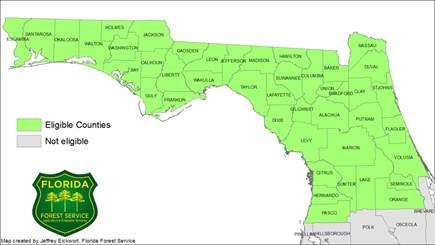 The southern pine beetle is one of the most economically devastating forest pests of the southeast, with periodic outbreaks leading to deaths of millions of pine trees. In 2017, 260 SPB infestations were reported in Florida, killing trees on 1,768 acres. This pales in comparison to the last major outbreaks between 1999 and 2002, which caused an estimated $59 million in timber losses. Since it was first offered in 2005, the program has been implemented on more than 183,000 acres and helped thousands of landowners.
The southern pine beetle is one of the most economically devastating forest pests of the southeast, with periodic outbreaks leading to deaths of millions of pine trees. In 2017, 260 SPB infestations were reported in Florida, killing trees on 1,768 acres. This pales in comparison to the last major outbreaks between 1999 and 2002, which caused an estimated $59 million in timber losses. Since it was first offered in 2005, the program has been implemented on more than 183,000 acres and helped thousands of landowners.
“These small infestations average less than an acre now, but they have the ability to expand rapidly this time of year,” said Jim Karels, State Forester and Director of the Florida Forest Service. “It’s imperative that we remain vigilant to keep this invasive pest at bay.”
The Southern Pine Beetle Assistance and Prevention Program, supported through a grant by the United States Forest Service, provides incentive payments for landowners who conduct a first pulpwood thinning and offers partial cost reimbursement for activities, such as prescribed burning, mechanical underbrush treatments, and the planting of longleaf or slash pine rather than the loblolly pine, the beetle’s preferred species. Qualified landowners can apply for up to two different practices per year, and funding requests may not exceed $10,000. All qualifying applications received during the submission period will be evaluated and ranked for approval.
To obtain an application or to learn more about the Southern Pine Beetle Assistance and Prevention Program, visit FreshFromFlorida.com/SouthernPineBeetle/Prevention.
Shrimp Beat The Wahoos
June 2, 2018
The Jacksonville Jumbo Shrimp got out to a fast start with three first inning runs against Blue Wahoos starter Vladimir Gutierrez (L, 1-8) and never looked back on their way to a 4-0 win Friday night at the Baseball Grounds of Jacksonville.
 The first four Shrimp reached in the first inning before Gutierrez struck out Eric Jagielo for the first out of the inning. Isan Diaz singled home Kyle Barrett for the first run, then Monte Harrison scored on a fielder’s choice before Diaz come home on a single from Brian Schales.
The first four Shrimp reached in the first inning before Gutierrez struck out Eric Jagielo for the first out of the inning. Isan Diaz singled home Kyle Barrett for the first run, then Monte Harrison scored on a fielder’s choice before Diaz come home on a single from Brian Schales.
They added another run in the third with Sharif Othman hit a long single to centerfield which scored Jagielo from second. Gutierrez struggled with his control throughout his 2.1 innings on the hill for the Wahoos. He finished with four walks and a hit batter. Two of the walks and the hit batsman scored to account for three of the Jacksonville four runs. The Wahoos starter did get five strikeouts and allowed just three hits. Four Blue Wahoos pitchers combined to strike out 10 Jumbo Shrimp batters over the seven-inning game.
Kolton Mahoney and Major League rehabber Brett Graves (W, 1-1) worked seven scoreless innings with nine strikeouts. Graves pitched the final three innings for the win.
The contest was supposed to be the first game of a doubleheader, but the start was delayed for nearly three hours forcing the second game to be moved to Saturday as part of a doubleheader.
Saturday’s twin-bill will start at 4:05 c.t. when RHP Wyatt Strahan (4-4, 6.70) takes the hill against RHP Robert Dugger (0-0, 5.40). Game two will feature LHP Seth Varner (2-0, 3.33) against RHP Max Duval (1-5, 6.45).
Beat The Summer Heat With Florida Fruit Salad With Lime And Honey
June 2, 2018
Summer weather is here. Beat the heat with quick and easy recipes like this Fresh From Florida Fruit Salad with lime and honey.
Florida Fruit Salad with Lime and Honey
Ingredients:
1/4 seedless Florida watermelon (depending on size), peeled and diced large
2 Florida mangoes, peeled and diced large
1 pint Florida blueberries, rinsed
2 tablespoons Florida honey
1/4 cup fresh mint, hand torn
2 limes, juiced
fresh citrus for garnish, sliced
1 small pinch sea salt
Preparation:
In a medium-sized mixing bowl add lime juice, honey, and salt. Stir the lime juice mixture to get the flavors working together. Add all of the rest of the ingredients, and gently stir to combine. Keep fruit salad refrigerated until ready to eat. This dish can be made a day ahead. Garnish fruit salad with fresh sliced citrus.
PPD: Man Damaged Monument At Pensacola Veterans Memorial Park
June 1, 2018
Pensacola Police have arrested a man and charged him with felony criminal mischief after he intentionally caused damage to memorial display at the Veteran’s Memorial Park downtown.
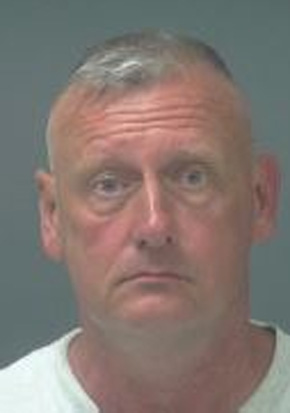 Police charged 55-year old Robert Link of the 5000 block of Paddlewheel Drive in Milton with the incident, which damaged a section of the Global War on Terror Memorial, which contains an actual piece of the World Trade Center.
Police charged 55-year old Robert Link of the 5000 block of Paddlewheel Drive in Milton with the incident, which damaged a section of the Global War on Terror Memorial, which contains an actual piece of the World Trade Center.
Link damaged the display on Wednesday of last week, then returned again on Saturday and damaged it a second time. Link was hanging onto the display, and his body weight caused it to bend, according to police.
“It was really devastating to find out that someone would deface a brand new monument like that, that has such significance to everyone in our community and country,” said Paul Entrekin of Walnut Hill, a Veterans Memorial Park board member. “To damage the artifact from the World Trade Center, that was terrible.”
Entrekin said the damage has been repaired, and the new monument will be dedicated on June 14 at 7 p.m. during a Memorial Day ceremony that was delayed due to Subtropical Storm Alberto.
Pensacola Police Chief Tommi Lyter said the park is a place of solemn reflection, and it should be treated in the same manner as a cemetery.
Pictured top: The Global War on Terror Memorial at Pensacola Veterans Memorial Park. Park officials said the “bent” piece in the eagle’s talons was the result of the vandalism and has now been repaired. Photo for NorthEscambia.com, click to enlarge.
Century Inmate Receives Life For Prisoner Stabbing Death
June 1, 2018
Friday morning, an inmate was sentenced to life in prison for stabbing another inmate over an alleged bad debt inside Century Correctional Institution.
 Robert L. Hunt was charged with second degree murder for the June 19, 2017, incident.
Robert L. Hunt was charged with second degree murder for the June 19, 2017, incident.
Judge Jan Shackelford sentenced Hunt to life in state prison as a prison releasee reoffender. He will not be eligible for parole.
According to a Florida Department of Law Enforcement arrest affidavit, Hunt stabbed inmate Jorge Slaughter multiple times in the abdomen with a metal weapon inside the G Dorm. Slaughter died from his injuries a short time later at Century Correctional.
Preliminary findings from Slaughter’s autopsy indicated that the weapon used by Hunt caused Slaughter to bleed out internally.
The entire incident was captured on video by security cameras inside the dorm. Inmates who witnessed the incident identified Hunt as Slaughter’s attacker. Witnesses also told the FDLE that Hunt attacked slaughter over an unspecified debt that Slaughter owned Hunt.
Slaughter, 30, was serving a 30 year sentence out of Miami-Dade for armed burglary, grand theft and robbery. Hunt was serving a 15 year sentence out of Polk County for attempted robbery with a gun or deadly weapon. He had previously served a year and a half for aggravated assault with a weapon and methamphetamine possession.
Slaughter’s family filed a federal wrongful death lawsuit against the Florida Department of Corrections the then-warden.
Florida Prison Visitation Changes Spark Outcry
June 1, 2018
Tearful, angry and resentful family members of Florida inmates pleaded Thursday with state corrections officials to abandon proposed changes to visitation rules that could cut in half the amount of time they are able to spend with locked-up loved ones.
The Department of Corrections is proposing a change that would allow the agency to limit prison visits — which can now take place on Saturday and Sunday, in addition to holidays — to every other weekend. Under the proposed rule, changes to the “standard” visitation schedule would be implemented on a prison-by-prison basis and would be based on a variety of factors, such as staffing shortages and the amount of contraband being sneaked into the institutions.
The proposal eased off an original plan, floated last month, which could have allowed corrections officials to impose the reduced visitation schedule throughout the prison system and reduce the current six-hour daily visitation period to two hours.
But the modifications did not eliminate the concerns of dozens of people who urged corrections officials to drop the plan during a hearing about the proposed rule Thursday,
“I really don’t want my visits or anyone’s visits to be taken,” 11-year-old Cody Calhoun told prison officials, saying he “will be devastated” if the change goes into effect. “Why would you even take them away? I mean, they’re already having a bad enough time in prison. Why would you make it worse? Please. I need to see my dad on the weekends. … I love playing with him and it brings me closer to him.”
Families and prison-reform experts pointed to research showing that face-to-face visits play a significant role in reducing recidivism and assisting ex-inmates to re-enter society when they are released. The critics also relied on studies showing that visitors are responsible for just a fraction of the illicit items, such as cigarettes and cell phones, brought into prisons.
But Richard Comerford, assistant deputy secretary of institutions for the Department of Corrections, said those concerns, and others, were taken into consideration when corrections officials modified the proposed visitation changes, which would only go into effect if needed.
“We’ll evaluate that visitation schedule based on institutional security, staffing, safety and security of the inmates, visitors and staff, the maximum capacity of these parks, the numbers of visitors and the frequency of contraband that’s introduced into our facilities,” he said.
Lawmakers placed such a value on visitation that it is included in a state law, which says that “maintaining an inmate’s family and community relationships through enhancing visitor services and programs and increasing the frequency and quality of the visits is an underutilized correctional resource that can improve an inmate’s behavior in the correctional facility and, upon an inmate’s release from a correctional facility, will help to reduce recidivism.”
If there are barriers or deficiencies regarding visitation, the law also requires the corrections secretary to submit budget requests “identifying capital improvements, staffing, and programmatic needs necessary to improve the quality and frequency of family visits and the visitation program and services.”
Prison officials are also responsible for “protecting society and citizens at large,” Department of Corrections lawyer Gregory Hill said at the onset of Thursday’s hearing.
“It’s with these two competing goals that the department has to compose these rules, and that’s what the department’s strived to do in revising and revamping the rule that’s been presented and will be presented here today,” he said.
But sharply reducing the time inmates can spend with their loved ones could put the public at risk, many of the speakers warned. Apart from committing more crimes when they are released, the reduction in visitation could lead inmates to riot, some cautioned.
Heather Walker said her “baby brother” has served five years of a life sentence.
“These visits are all that he has to look forward to. Decreasing them, taking them away, is no way going to help him,” a tearful Walker, who said she has another brother who is a corrections officer, said. “If this was your brother, this was your child, would you put these same standards into the law?”
About 100 people showed up for the hearing, including several who said they were traveling more than 16 hours round-trip to be able to speak.
Jodi Chambers-Wilson, whose son is in prison, said even more family members would have appeared but for the reason she kept silent on prison-related matters for seven years.
“Fear of retaliation. Period. Point blank,” an angry Chambers-Wilson said, reminding prison officials that the law requires them to encourage visitation.
“I birthed him, and I am allowed to visit him because the state Legislature says it is your responsibility to facilitate it. Let me be a mother to my son,” she said, receiving a standing ovation from the audience members.
The corrections agency — which houses 90,000 inmates — has been chronically underfunded and is currently running a budget deficit of nearly $80 million. Agency officials attribute about a third of the deficit to spending on contracts with private health-care companies and increases in the costs of prescription drugs.
The agency also is struggling with staffing shortages.
The corrections department is offering $1,000 hiring bonuses at 18 of Florida’s 50 state-run institutions, according to the department’s website. The bonuses are being offered at facilities that are at least 10 percent below desired staffing levels, agency spokeswoman Michelle Glady said in an interview.
But until the proposed rule is finalized, Glady said it’s impossible to know what the staffing standards would be to spark the “modified” visitation schedule.
“No one would argue that visitation isn’t valuable, that the family connections aren’t important, that having those connections contributes to the reduction of recidivism,” Glady said. “In-person visitation is very important, but we have to balance the security of the institution, and that’s why the rule outlines when we would have to go to a more modified schedule.”
Beth Gammie, a lawyer who has spent two decades representing people seeking clemency or parole, warned that the rule could be challenged because it fails to specify that the schedule would be modified if the frequency of contraband brought into a facility increases is due to visitors, “because that is apparently what you are trying to get at.”
After the meeting, Gammie said the biggest issue with the proposed rule is the modified visitation schedule.
“That’s clearly what they’ve been wanting all along,” Gammie said, referring to the corrections department. “They know that visitation is positive. So this whole rulemaking effort, which they would only do if they want to change the present practice, they’re either ignoring that or it’s not mattering that much to them.”
by Dara Kam, The News Service of Florida
Take Stock In Children Awards $300K In Scholarships To Local Students
June 1, 2018
Take Stock in Children and the Escambia County Public Schools Foundation recently awarded $300,000 in scholarships to 21 graduating seniors.
Each student received a four-year scholarship and a laptop computer. The volunteer mentors who met weekly with their students were also recognized.
The 2018 Take Stock in Children graduates are
- Escambia High: Diamond Franklin
- Northview High: Jason Fischer, Kayla Galvan, Lari McCann
- Pensacola High: Latavia Grace, Aaliyah Medley, Markita Sapp, Joshua Van Fleet
- Pine Forest High: Lina Foust, Brianna Walker
- Tate High: Olivia Brown, Devin Searcy, Taylor Smith, Sabra Stewart
- Washington High: Armelle Delouis, DeMarcus Harris, Clay Johnson, Brooke Nemeth
- West Florida High: De’Shawn Brundidge, Dezmond Booker, Savon Johnson
Take Stock in Children was established in 1995 as a non-profit organization in Florida that provides a unique opportunity for deserving low-income students to escape the cycle of poverty through education. Students receive college scholarships, caring volunteer mentors, college readiness skills, and hope for a better life. Students are selected through a need-based application process in middle school, and comprehensive services continue through high school and include the students’ transition into college. Each student is matched with a volunteer mentor who meets with the student weekly at school.
Pictured top: (front row) Olivia Brown, Latavia Grace, Lari McCann, Kayla Galvan, Lina Foust, Taylor Smith, Sabra Stewart, Aaliyah Medley, Clay Johnson, Devin Searcy; (back row) Rep. Frank White, Dezmond Booker, Joshua Fan Fleet, Savon Johnson, Armelle Delouis, Superintendent Malcolm Thomas, Diamond Franklin, DeMarcus Harris, De’Shawn Brundidge, Brianna Walker and Rep. Clay Ingram. Not pictured: Jason Fischer, Brooke Nemeth and Markita Sapp. Photo for NorthEscambia.com, click to enlarge.


